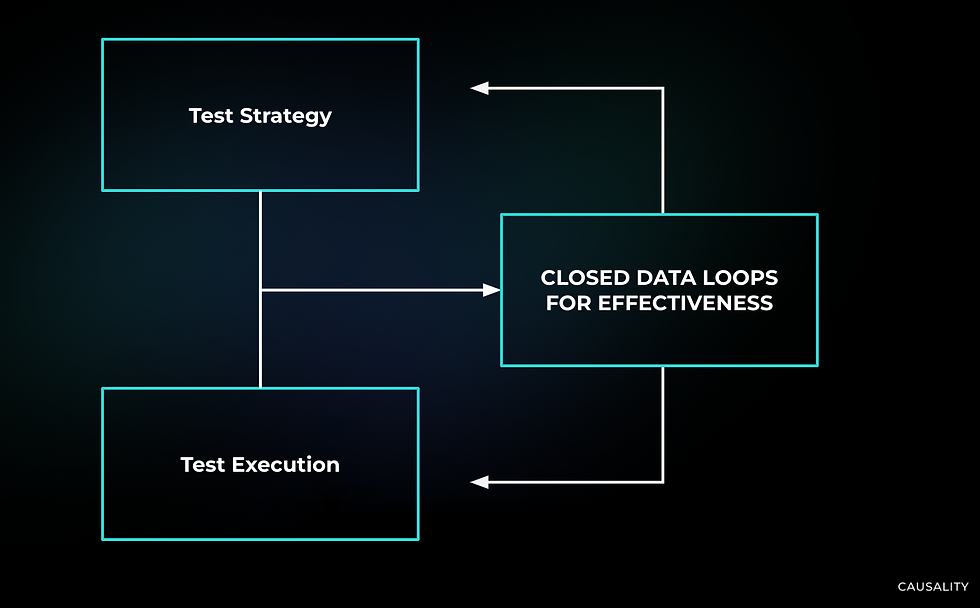How to Test Your Riskiest Product-Market Fit Assumptions: A Framework for Success
- David Isaac
- Sep 4, 2023
- 5 min read
Updated: Sep 5, 2023
TL;DR
Identifying and testing the riskiest product-market fit assumptions are key to a startup's success. Using customer journey maps rooted in Jobs-to-Be-Done (JTBD) theory, you can isolate these assumptions and create product features that address them. Robust product strategy and roadmap decisions that significantly boost your chances of product-market fit are dependant on this type of Riskiest Assumption Testing (RAT).
Introduction: Navigate Through Uncertainty with Confidence

In the turbulent waters of product development and market fit, assumptions are your navigational buoys.
But not all assumptions are created equal. Some can send your venture off course if not appropriately addressed. The ability to recognize and validate the riskiest among them can be the difference between success and a shipwreck.
Crafting Customer Journey Maps: A Fresh Perspective
Traditional customer journey maps may help you see how customers interact with your product, but they can lack depth when it comes to uncovering the critical "jobs" customers are hiring your product to do. By integrating Jobs-to-Be-Done theory into your customer journey maps, you gain a much richer understanding of the entire customer experience.
Within the Journey Maps, key value propositions (driven by features on your oadmap), key segments (defined by the outcome they really want) and GTM considerations ("How do I create a dependable flow of new customers?") all ladder up to hypotheses or assumptions. Which is the most critical? Which is so important that it's a dependency? That is where you begin your Riskiest Assumption Testing (RAT).
For example, Value Proposition-Channel Fit is often overlooked, but many serial founders believe the entire product is built around the primary acquisition channel. Do we build a standalone app? Or a Chat GPT plugin? Both need specific understanding of the target segment, their job to be done, and a go-to-market strategy to get them into a full funnel marketing approach.
Channel hypotheses are great candidates for RAT.
Value Proposition-Channel Fit is often overlooked, but many serial founders believe the entire product is built around the primary acquisition channel. Channels are GREAT candidates for Riskiest Assumption Testing
Translating Jobs to Features: The Benefits of Outcome-Driven Hypotheses
Creating outcome-driven hypotheses based on JTBD not only improves your understanding of what the customer values but also allows you to design features that cater to these specific outcomes. Each feature in your product roadmap should be a solution to a problem or a 'job' that the customer needs to be done. This fine-tuning significantly raises your odds of achieving product-market fit.

Isolating and Testing the Riskiest Assumptions
The hypotheses you've developed about customer outcomes guide you toward the riskiest assumptions that need to be tested. These are typically the ones that are least understood, least met, and most crucial to your ideal customer. By focusing on these, you avoid wasting time on less impactful areas, maximizing your resources and efficiency.
The Pathfinder Advantage
It's one thing to understand this framework theoretically, but another to implement it effectively. Platforms like Pathfinder offer a nuanced approach to defining your riskiest assumptions while aligning them with your feature set and broader business strategy. The result is a focused, streamlined path to product-market fit and successful fundraising. To explore how we can do this for you, visit Pathfinder.
Aligning Product Strategy with Go-to-Market (GTM) Business Experimentation: The Causality Framework Connection
When sailing the treacherous waters of product development, having a robust product strategy is only half of the battle. The other half lies in executing a successful go-to-market (GTM) strategy.
The two need to be tightly aligned, functioning almost like two gears in a well-oiled machine. When done right, they create a closed data-loop, helping teams understand what is not working, and why. enabling this type of hypothesis-based execution helps create a causal inference loop, helping teams understand cause and effect, and know whether strategy needs to be iterated, or just execution.
In this way, more rapid progress can be made, and teams are no longer paralysed from insufficient clarity on what to do next.
Here's where Causality Co Frameworks come into play. These frameworks help you understand the causal relationships between various elements in your business model and market dynamics. They assist you in predicting how changes in one area (like a focus on a specific job-to-be-done defined customer segment) will influence outcomes in another (like customer adoption rates of free-to-paid user states).
A well-aligned product strategy and GTM plan ensure that your marketing and sales efforts are directly built upon the value propositions and differentiators that your product offers. This alignment reduces market friction, increases customer adoption, and propels you toward product-market fit at a faster rate.
The Four Fits and Business Model Canvas: The Ultimate Validation Test
Building upon the Business Model Canvas by Osterwalder, the concept of Four Fits takes a closer look at the interactions between your product and market, emphasizing the most logical and insightful variations for the "four key fits ("4 fits") hypotheses Causality Co. tests between the business model elements of
customer niche,
value proposition,
channel and
revenue model
These variations should reflect potential strategies that could drive regular new user growth, stable or growing product engagement, retention on the product, all driving monetization and profitability.
Remember, the aim of this exercise is to guide the client in understanding how their app idea can be transformed into a robust, validated, and customer-centric strategy that aligns product strategy with go-to-market strategy.
These fits are essentially hypotheses you execute around, and they align closely with the riskiest assumptions you've identified.
Precision Positioning and Niche Focus: The Hallmarks of a Well-Defined Strategy
In a world bombarded with generic solutions, precision positioning and a niche focus become invaluable assets. Focusing on a well-defined target market allows you to become a specialist rather than a generalist, making it easier to address the 'jobs' your product is hired to do more effectively.
With the Four Fits, you need to be surgically precise. The riskiest assumptions often lie in these fits, especially if your product is new or disruptive. A generic approach here will not suffice.
Why Proving the Four Fits is Crucial
Without adequately validating and proving each of the Four Fits, achieving stickiness and scale remains a distant dream. Validation helps turn risky assumptions into measurable outcomes.
For instance, if your product-market fit hypothesis falls flat, it’s likely that your market-model fit will be affected, causing a ripple effect across your entire business. Inadequate validation of these fits can lead to poor adoption rates, ineffective marketing strategies, and a dilution of your core value propositions. That's why this validation process is not a one-off exercise but a continuous loop that feeds into your ongoing efforts to refine your product and GTM strategies.
By diligently aligning your product strategy with your GTM plans and focusing on proving the Four Fits, you ensure that your venture is built on a rock-solid foundation. Your riskiest assumptions are nothing but challenges waiting to be decoded, offering you insights that can make your product indispensable to your customers.
This precise focus and alignment are what separates successful startups from those that get lost in the sea of possibilities.
Conclusion: The Power of Focused Strategy
Isolating and testing the riskiest product-market assumptions doesn't have to be an insurmountable challenge.
By adopting a robust framework that incorporates customer journey mapping and outcome-driven innovation, you can approach this task with much greater confidence and effectiveness. This method sets your feature development on a more targeted course, bringing you closer to that elusive product-market fit.
For those interested in an integrated approach that encompasses everything from fundraising assets to deep product strategy, consider taking a streamlined, specialized path. A focused methodology not only increases your odds of achieving product-market fit but also simplifies your journey from idea to launch.
FAQs
What is Jobs-to-Be-Done (JTBD)?
JTBD is a theory that helps identify the specific 'jobs' or outcomes that customers are seeking to achieve through your product.
How do I Identify Risky Assumptions?
Isolate hypotheses related to customer outcomes that are least understood, least met, and most vital to your target customer. These are your riskiest assumptions.
How Do Features Align with Risky Assumptions?
Once you have identified the riskiest assumptions, you can prioritize feature development to directly address these areas. This leads to more strategic product development and greater alignment with customer needs.











Comments